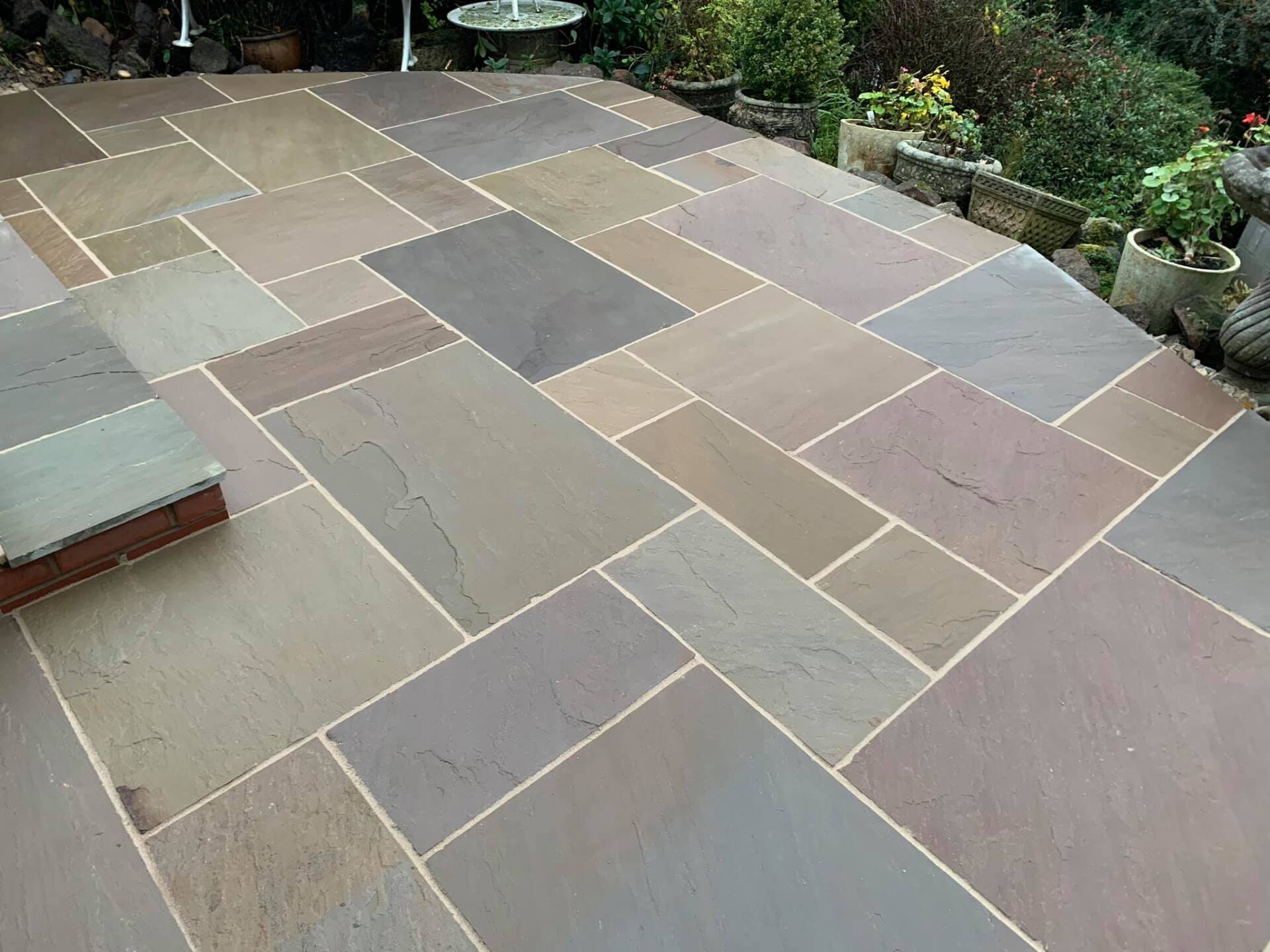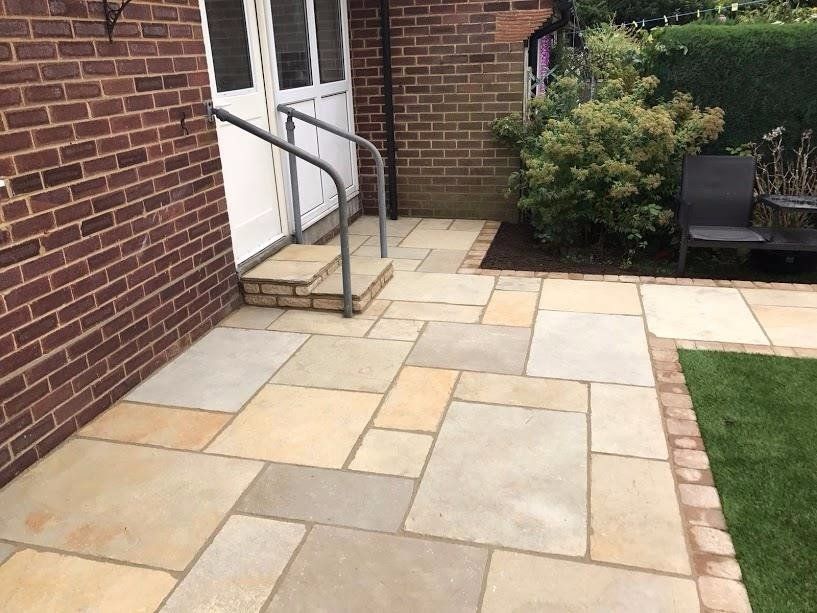Indian Stone Patio Leeds
Indian Paving Leeds
Well unsurprisingly the clue is in the name. Indian Stone mostly comes from India so is a natural, imported product. It's popularity has gradually increased to now be one of the most popular choices for both paving, patios and driveways and is often proposed by landscaping companies as a great looking yet affordable patio option.
Since they are a natural product they have rustic appearance, which is perfect for blending into landscaping projects and have good durability but are quite porous - which means that, untreated, water could absorb into the stone. Once there, it has the potential to expand in frost, potentially causing paving stones to crack. However, when properly sealed you will have a great looking patio for many years.
Indian Stone Patio Installlation
Here's a recent installation we did for a customer in Leeds using Raj Green Indian Stone which incuded a step doen from the kitchen and patio doors and several steps down to the garden.
Indian Stone Options
As well as a number of variations in the colours the edging can also vary. This will depend on how the stone has been cut. If a saw has been used then you will have neat consistent edges and thickness of your paving slabs, hand cut slabs on the other hand will have much more variance in thickness and edges will be rougher. These hand cut Indian stones work exceptionally well if you are aiming for a old style cottage, rustic look.
As mentioned Indian stone has also grown in popularity for use in driveways. However, if you are looking to have a consistent Indian stone finish from the front to back of your house with a pathway connecting the two you need to ensure that your paving or driveways contractor is not using the exact same Indian paving stones for both your path and patio as well as your driveway.
Indian Stone driveway slabs should be thicker to take the additional weight, movement and more general wear and tear than that on a typical patio. Whilst you could chose to have all areas paved with driveway grade Indian stone, as it is a thicker slab it will be more expensive so this will add to your overall costs and is unlikely to be required - so could be said to be 'over specified' if use for pathways and patios. Clearly it will perform exceptionally well but if you are working to a budget this is worth knowing.
As well as options in thickness and edges the most visual aspect will be the colour options. Some of the good quality trade suppliers will have a range of off white shades, sandstone and darker buff shades to choose from. This will also include stabs which are distinctly a single tone and those which exhibit a couple. However, what is quite popular is to have a mix of several colours and sizes to provide a unique and interesting patio finish.
Looking after Indian Stone Paving
As previously mentioned the only possible negative surrounding Indian stone is its porous characteristic. This increase the likelihood of possible breakages following extremely cold weather but will not definitely be the case. It is a natural product so is used to the elements but as a result it is also prone to fading which again can make your paving continue to look more natural. However, this is a preference issue and can easily dealt with by applying an appropriate sealant. As well as protecting your stone from moisture absorption it will also protect them from fading. Sealants will either be available as clear or coloured, the latter will allow you to enhance the colour of your paving if desired. It is a relatively easy task to apply and only needs to be doe once every few years. As with all patio options our experts will be happy to discuss all options with you.
Need help?
Looking to install Indian Stone Paving in Leeds?
Frequently Asked Indian Stone Patio Questions
-
Can you paint Indian Stone patio slabs?
The brief reply to the question is yes. However, if you are thinking of repainting your outdoor patio rather than replacing it you truly ought to not try to do this on a tight budget - which may seem counterintuitive but it will be counterproductive.
Top-quality acrylic based paints would certainly be best. However, you must understand that to provide resilience these paints will certainly require to be applied heavily and also in numerous coats with a brush or roller. Also, they should be allowed to completely dry normally for a couple of days, so please inspect the forecast prior to starting this course of action. These paints are often designed for warehouses for marking safety routes so the colour options may also be a little unnatural for a garden environment.
With a painted patio - remember this is just a layer and will undergo table and chair bumps and scrapes. It may give a band-aid approach to boosting the look of your patio for a little while but once the paint starts to chip away attempting to overpaint once more will certainly not look great!
-
Can you lay Indian Stone patio slabs straight onto grass?
Of course, you can simply lay a paving piece on any surface area however you need to think about what will be completed effect. If you just intended to use a few slabs simply as a stepping rock then with a little sand and a little work with a spade you could level the ground to place a paver that can be stepped on without wobbling for a while. However, if you are intending on utilising chairs, tables, bar-b-ques you really should set your paving slabs into an effectively-prepared sub-base, which will certainly provide a strong, flat base for your pavers to then be fixed onto a mortar base. This will prevent weeds from showing up via paving joints and also ensure you do not have loose or unsteady paving stones.
-
Which is better for a patio area - decking or Indian stone paving?
Clearly, an installer who only does one of these will persuade you down that particular path. However, there are some scenarios where one may have the edge over the other. One of the main ones being the budget you are working with.
As a quick comparison - especially against wooden decking a patio made up from any of the slab options we have covered will be stronger, and as a result, last longer and require less maintenance. However, if you want to have a large single level social area and have a garden on a steep slope decking will offer a more cost-effective solution. The decking can be laid on a frame, which can simply be build up from the lower end of the slope. To do the same for a paved patio will require much more death moval and supporting walls to be constructed so will be more costly.
-
Can the same Indian stone paving slabs be used for a driveway?
Yes - certain types of paving can also be used for a driveway so you can have consistent paving from the front of your house down the sides and to your back garden patio.
Not all pavers will be suitable but granite setts and driveway grade Indian stone would be perfectly good choices for this.
-
What's the best way to clean an Indian Stone patio
Clearly, this will depend on how dirty your patio is and whether or not staining has taken place.
For regular quick and easy cleaning simply mixing a cup of washing up liquid in a bucket of warm water and brushing this across your patio with a firm bristled brush is suitable for all types of pavers.
Pressure washing can be used for most pavers but this can remove sealers - although thoroughly cleaning this way will be good preparation for re-sealing when dry. with a pressure washer you should be more careful near the joints as high pressure can damage and dislodge jointing. If this does happen it is best to apply some jointing compound to prevent this from becoming an area for weed and algae growth. There are many options on the market, many of which can simply be brushed into the gaps so no DIY skills requried.
Business Hours
- Mon - Sun
- -
All Rights Reserved | Paving Leeds - Leeds paving contractors



